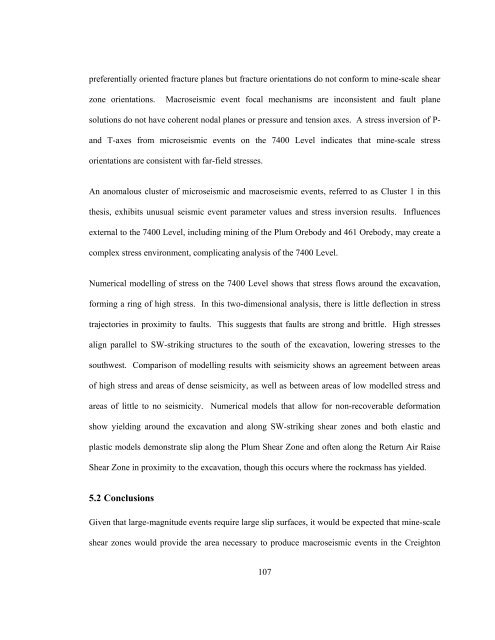title of the thesis - Department of Geology - Queen's University
title of the thesis - Department of Geology - Queen's University
title of the thesis - Department of Geology - Queen's University
Create successful ePaper yourself
Turn your PDF publications into a flip-book with our unique Google optimized e-Paper software.
preferentially oriented fracture planes but fracture orientations do not conform to mine-scale shear<br />
zone orientations. Macroseismic event focal mechanisms are inconsistent and fault plane<br />
solutions do not have coherent nodal planes or pressure and tension axes. A stress inversion <strong>of</strong> P-<br />
and T-axes from microseismic events on <strong>the</strong> 7400 Level indicates that mine-scale stress<br />
orientations are consistent with far-field stresses.<br />
An anomalous cluster <strong>of</strong> microseismic and macroseismic events, referred to as Cluster 1 in this<br />
<strong>the</strong>sis, exhibits unusual seismic event parameter values and stress inversion results. Influences<br />
external to <strong>the</strong> 7400 Level, including mining <strong>of</strong> <strong>the</strong> Plum Orebody and 461 Orebody, may create a<br />
complex stress environment, complicating analysis <strong>of</strong> <strong>the</strong> 7400 Level.<br />
Numerical modelling <strong>of</strong> stress on <strong>the</strong> 7400 Level shows that stress flows around <strong>the</strong> excavation,<br />
forming a ring <strong>of</strong> high stress. In this two-dimensional analysis, <strong>the</strong>re is little deflection in stress<br />
trajectories in proximity to faults. This suggests that faults are strong and brittle. High stresses<br />
align parallel to SW-striking structures to <strong>the</strong> south <strong>of</strong> <strong>the</strong> excavation, lowering stresses to <strong>the</strong><br />
southwest. Comparison <strong>of</strong> modelling results with seismicity shows an agreement between areas<br />
<strong>of</strong> high stress and areas <strong>of</strong> dense seismicity, as well as between areas <strong>of</strong> low modelled stress and<br />
areas <strong>of</strong> little to no seismicity. Numerical models that allow for non-recoverable deformation<br />
show yielding around <strong>the</strong> excavation and along SW-striking shear zones and both elastic and<br />
plastic models demonstrate slip along <strong>the</strong> Plum Shear Zone and <strong>of</strong>ten along <strong>the</strong> Return Air Raise<br />
Shear Zone in proximity to <strong>the</strong> excavation, though this occurs where <strong>the</strong> rockmass has yielded.<br />
5.2 Conclusions<br />
Given that large-magnitude events require large slip surfaces, it would be expected that mine-scale<br />
shear zones would provide <strong>the</strong> area necessary to produce macroseismic events in <strong>the</strong> Creighton<br />
107

















